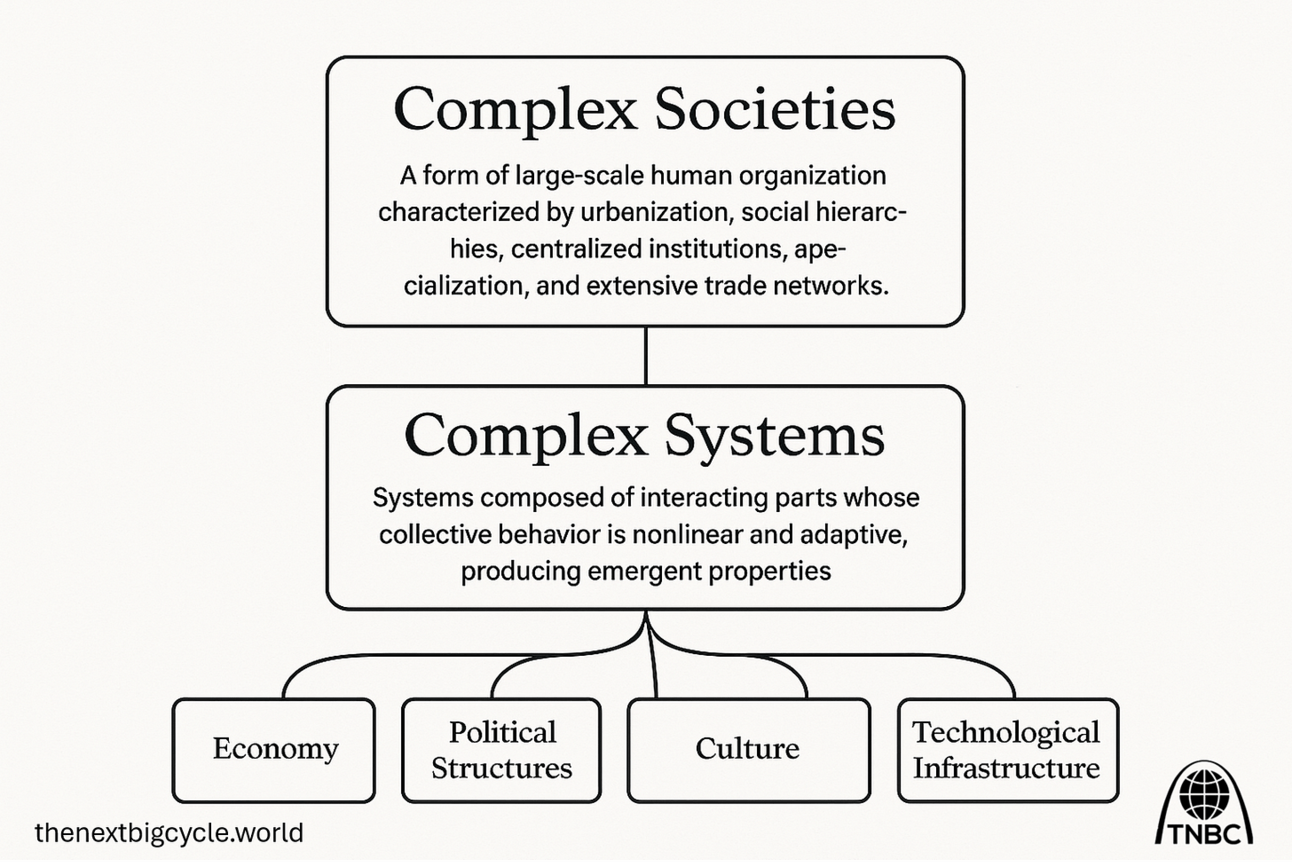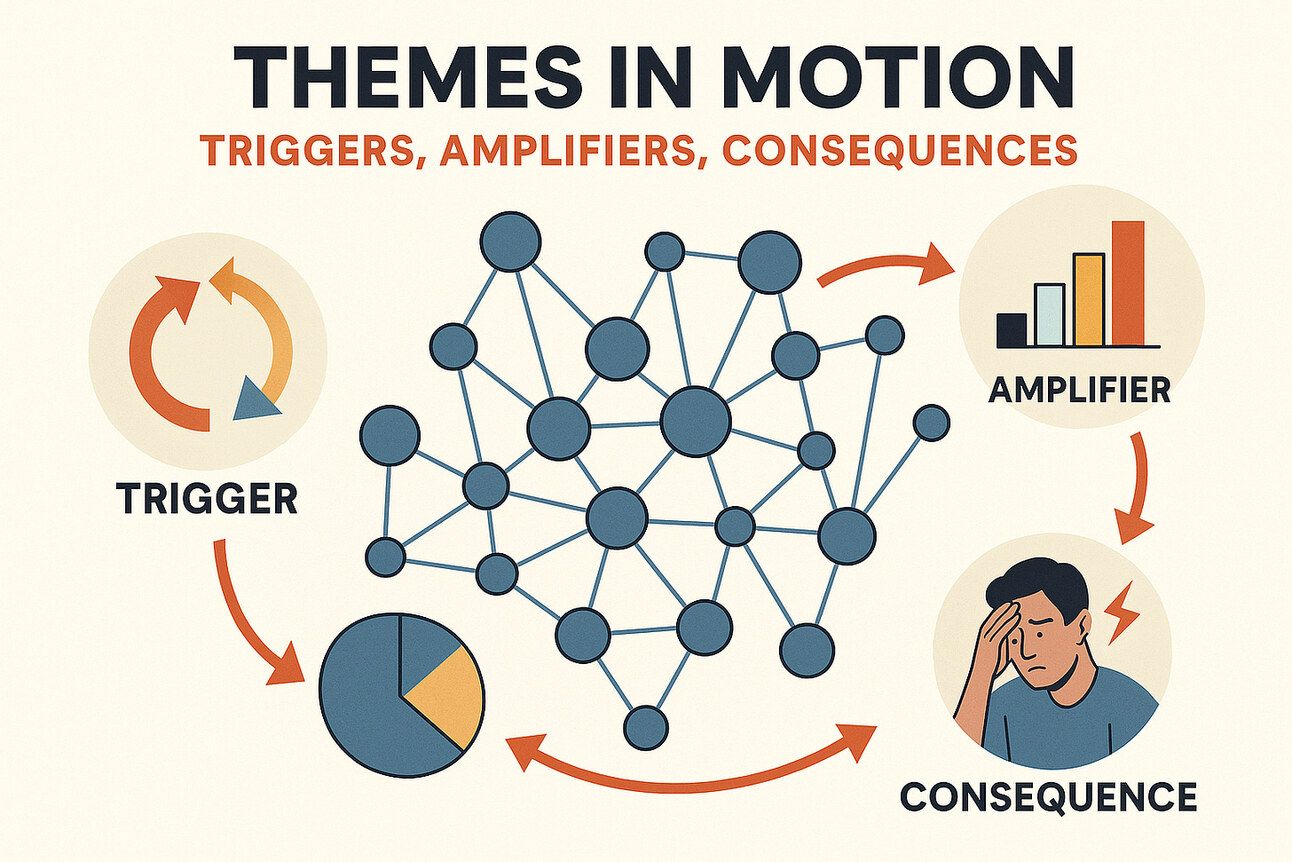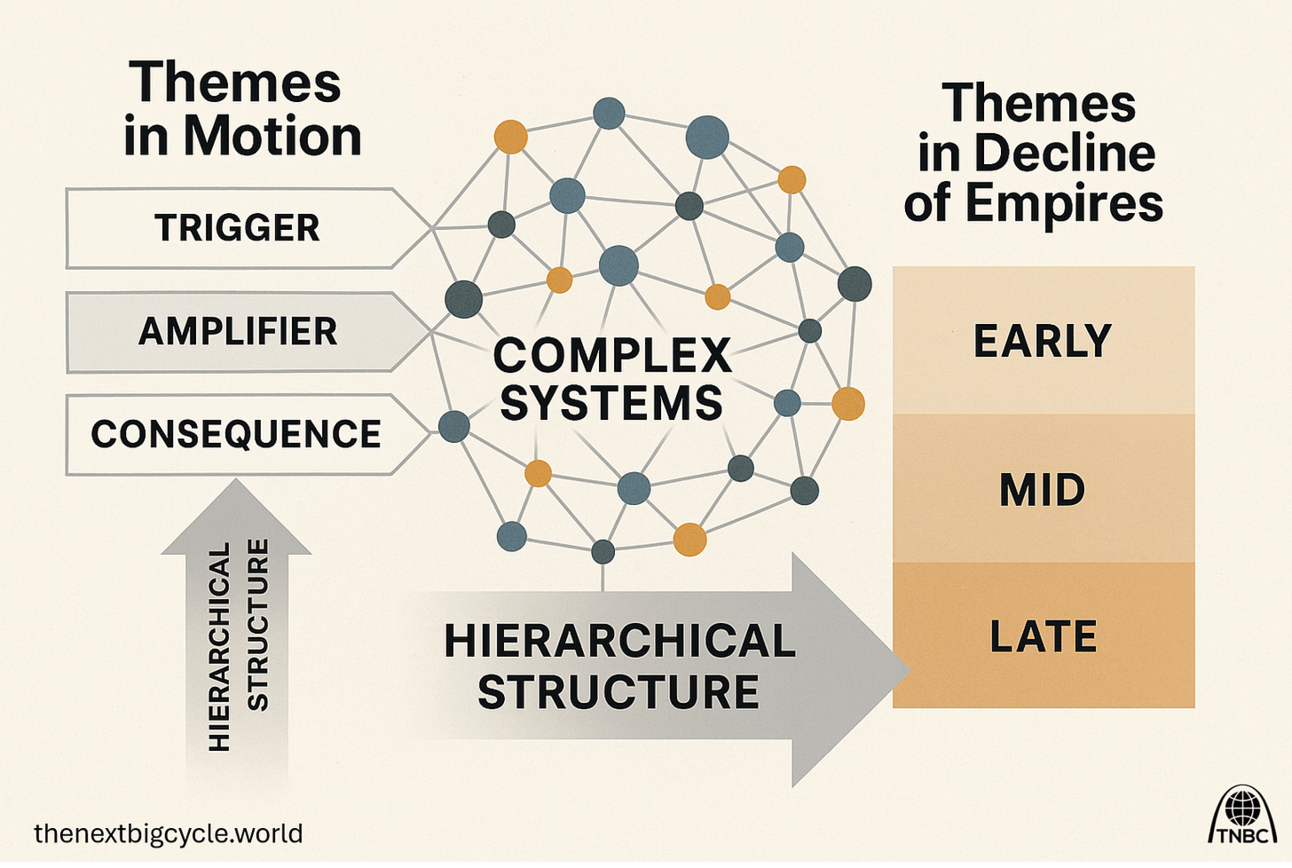
We Live in a Complex System – Forces Shaping Civilizations in Cycles
About this Series
In the series Turning Themes, we explore the overarching forces that shape our world -economic, political, social, and technological. Each entry examines how these broad themes interact in cycles, driving the rise, decline, and transformation of civilizations.
It Seems Like Chaos — Until You See the System
In today’s digital environment, individuals are inundated with a relentless flow of information - breaking news alerts, emotionally charged headlines, and fragmented updates all competing for our attention. This constant emphasis on the present moment fosters a perception that the world is in a state of continuous crisis. News events often appear chaotic and disconnected, driven by unpredictable human behavior, natural disasters, or sudden shifts in political and economic systems.
The psychological impact of this information overload is significant. Many individuals respond by disengaging from current events altogether, while others remain highly reactive, often expressing frustration, anxiety, or outrage through social media and other platforms. This dynamic not only distorts public perception but also erodes the capacity for critical thought and long-term understanding.
The good news is that this experience is not inevitable. By stepping back and examining the deeper patterns and structures that shape our world, we can begin to make sense of what initially appears to be random noise.
From Chaos to Complexity
Let’s now move from the perception of chaos to complexity by understanding the world as a complex system.
Complex Societies
A complex society refers to a form of human organization characterized by large-scale social structures, institutional specialization, economic surplus, and centralized governance. These societies are marked by features such as urban development, written language, class hierarchies, bureaucratic administration, and expansive trade networks. From ancient empires to modern nation-states, complex societies emerge when populations grow and new layers of coordination are required to manage resources, conflict, and collective identity. As they evolve, they become increasingly dependent on intricate institutions - legal systems, financial markets, transportation networks, and education systems - that allow large groups of people to function as a cohesive whole.
Complex Systems
A complex system, by contrast, is a conceptual framework used to describe any system composed of many interacting components whose collective behavior is non-linear, adaptive, and often unpredictable. Examples range from ecosystems and weather systems to neural networks and financial markets. What defines a complex system is not merely the number of parts it contains, but how those parts interact, self-organize, and evolve over time. Complex systems exhibit emergent properties - patterns or outcomes that cannot be easily explained by analyzing individual elements in isolation. Feedback loops, tipping points, and path dependency are central characteristics.

Complex Societies and Complex Systems
How They Relate
A complex society is, in essence, an umbrella that encompasses multiple complex systems. The economy, political structures, cultural norms, technological infrastructure, and environmental context within a society each behave as distinct complex systems, constantly influencing one another. For example, a political shock might destabilize markets, which in turn affects social cohesion or cultural attitudes. Understanding complex societies, therefore, requires thinking in systems—not just observing isolated events but recognizing how feedback and interdependence shape outcomes. By applying systems thinking to complex societies, we gain a more accurate lens for analyzing why civilizations evolve, how they respond to stress, and why they ultimately transform or collapse.
Not All AI Notetakers Are Secure. Here’s the Checklist to Prove It.
You wouldn’t let an unknown vendor record your executive meetings, so why trust just any AI?
Most AI notetakers offer convenience. Very few offer true security.
This free checklist from Fellow breaks down the key criteria CEOs, IT teams, and privacy-conscious leaders should consider before rolling out AI meeting tools across their org.
Themes in Motion
Themes are recurring forces or patterns—economic, political, social, technological—that shape the trajectory of civilizations. In our work, themes are more than categories; they are dynamic signals that help explain not just what is happening, but why. Their relevance lies in their ability to reveal the underlying structure of events that might otherwise appear chaotic or random. By mapping themes functionally and temporally, we gain insight into the mechanics of systemic change, helping us trace how empires rise, decay, and transform.
Themes can be organized in two complementary ways: as a hierarchical structure or as a complex system.
A hierarchical approach groups themes by domain - such as economic, political, social, or technological—providing a clear overview of systemic layers. This structure is useful for identifying areas of stress or transformation within a society.
In contrast, viewing themes as a complex system emphasizes their interdependence and feedback loops, where no theme stands alone and each can influence, amplify, or reshape others over time. In this dynamic view, themes act as nodes in a constantly evolving network, where relationships matter as much as content.
This dual framing - categorical and relational - allows us to both classify and connect themes, giving us a deeper and more actionable understanding of how systemic change unfolds across time, scale, and context.
In our exploration of the changing world order, we use themes as analytical tools to trace the forces shaping systemic transformation. Rather than treating themes as isolated or rigid categories, we approach them as nodes in a dynamic network. Each theme can trigger, amplify, or in some cases mitigate the effects of others. For example, inflation (an economic trigger) can increase wealth inequality (a social amplifier), which then fuels populist sentiment (a political consequence). In contrast, tools like propaganda may temporarily delay systemic breakdown by reinforcing legitimacy, even as deeper fractures continue to grow.
To make these relationships visible, we apply a method of cross-mapping—highlighting how events and stressors bridge across thematic domains. For instance:
→ Inflation (Economic Stressor)
→ Wealth Gap (Social Fracturing)
→ Institutional Distrust (Institutional Decay)
→ Populism (Legitimacy Crisis)
Similarly:
→ Cyberwarfare (Tech Disruption)
→ Narrative Collapse (Legitimacy and Morality)
→ Geopolitical Escalation (External Conflict)
Rather than treating themes as static “folders,” we label them by function: what role they play in the decline process. For example, inflation is not simply an economic issue - it’s a destabilizing trigger. Propaganda is not just a form of social control - it’s a temporary adhesive holding together eroding trust. This reframing allows a single event to be interpreted through multiple lenses, offering a more nuanced understanding of its systemic impact.
To keep this framework flexible but intelligible, we assign each theme a functional label:
Trigger – sets instability in motion (e.g., debt crisis)
Amplifier – escalates or spreads systemic stress (e.g., wealth gap, polarization)
Consequence – reveals the breakdown (e.g., social unrest, war)

Complex Societies and Complex Systems
Themes in Decline of Empires
Time also plays a key role in how themes unfold. In early-stage decline, we often see structural forces, economic imbalances, and cyclical patterns at work. Mid-stage decay involves institutional dysfunction, technological disruption, and legitimacy challenges. Late-stage collapse is marked by social fracturing, geopolitical conflict, and acute system failures. This temporal layering allows us to map not just where we are - but where we’re likely headed.
By using this thematic and functional framework, our articles aim to decode complexity, reveal the interdependencies driving global disruption, and help readers see past the noise of daily headlines into the larger patterns shaping our world.
Why Themes Matter
This dual framework provides two complementary lenses: one functional and dynamic (triggers to consequences), the other structural and thematic (domains of systemic strain). Together they help trace both how and where decline manifests in the fall of empires.

Two Lenses, One Framework: Mapping the Forces Reshaping the World
Understanding and using themes is central to the mission of TNBC. While this framework may appear complex, its core purpose is not academic theory - it’s clarity. By revealing the structure behind what often seems like chaos, themes help us connect the dots between current events and long-term systemic patterns. Over time, we’ll continue to build and refine this thematic structure, guided by history, systems thinking, and observable trends. But we won’t overcomplicate it. This is a science in itself, and TNBC doesn’t aim to be an exhaustive model. Our focus is to help people recognize patterns, understand systemic forces, and see the world with sharper perspective, even in times of disruption.
Worried it’s too abstract? The upcoming articles in the Turning Themes series will focus on practical, real-world applications.


